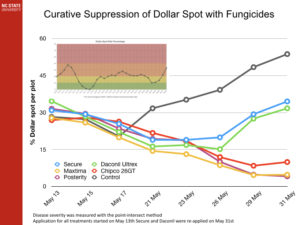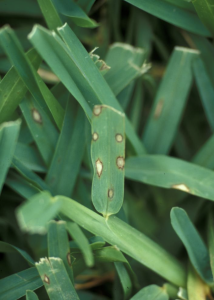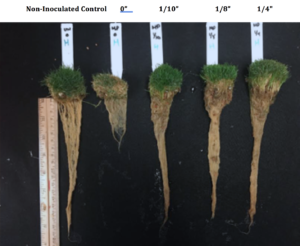
My Turf is Sick! Spray a Fungicide and Call Me in Two Weeks
By Jim Kerns, Lee Butler, and Nicholas Slipchenko All too often turf managers spray a fungicide when disease develops and …


El inglés es el idioma de control de esta página. En la medida en que haya algún conflicto entre la traducción al inglés y la traducción, el inglés prevalece.
Al hacer clic en el enlace de traducción se activa un servicio de traducción gratuito para convertir la página al español. Al igual que con cualquier traducción por Internet, la conversión no es sensible al contexto y puede que no traduzca el texto en su significado original. NC State Extension no garantiza la exactitud del texto traducido. Por favor, tenga en cuenta que algunas aplicaciones y/o servicios pueden no funcionar como se espera cuando se traducen.
Inglês é o idioma de controle desta página. Na medida que haja algum conflito entre o texto original em Inglês e a tradução, o Inglês prevalece.
Ao clicar no link de tradução, um serviço gratuito de tradução será ativado para converter a página para o Português. Como em qualquer tradução pela internet, a conversão não é sensivel ao contexto e pode não ocorrer a tradução para o significado orginal. O serviço de Extensão da Carolina do Norte (NC State Extension) não garante a exatidão do texto traduzido. Por favor, observe que algumas funções ou serviços podem não funcionar como esperado após a tradução.
English is the controlling language of this page. To the extent there is any conflict between the English text and the translation, English controls.
Clicking on the translation link activates a free translation service to convert the page to Spanish. As with any Internet translation, the conversion is not context-sensitive and may not translate the text to its original meaning. NC State Extension does not guarantee the accuracy of the translated text. Please note that some applications and/or services may not function as expected when translated.
Collapse ▲
By Jim Kerns, Lee Butler, and Nicholas Slipchenko All too often turf managers spray a fungicide when disease develops and …
– By Daniel Freund, M.S. student For those who manage golf course putting greens, Pythium root rot should be on …

While we conduct 60-70 field trials annually, these are a few of the more interesting ones we thought we …
As we come out of the gray days of winter and the soils start to warm up, it is …

We believe all turfgrass managers are interested in maximizing the efficacy of their fungicide applications. In fact, many superintendents …
Overall, total turfgrass samples submitted in 2018 to the NC State Turf Diagnostics Lab were nearly identical to total …

Gray leaf spot (GLS) is caused by the fungus Magnaporthe oryzae and is a destructive disease of St. Augustinegrass, perennial …
With summer weather and heat officially here for the next three months, summer stress will start to develop on …

Fairy ring is a problematic disease of sand-based putting greens, especially on ultradwarf bermudagrass (UBD) putting greens. Previous research …
Overall, turfgrass samples submitted to the NC State Turf Diagnostics Lab were up by 9% when compared to 2016. …

Many soilborne pathogens infect the crowns, stolons, rhizomes, and roots of turfgrass plants often causing detrimental outbreaks of disease. …

As soil temperatures continue to rise, we will see an increase in parasitic nematode feeding pressure and population size. …
The unusual weather in the Carolinas this fall and winter have led to substantial patch development on ultradwarf bermudagrass …
Overall, turfgrass samples submitted to the NC State Turf Diagnostics Lab were down by 6% when compared to 2015. …
The NC State Turf Diagnostics Lab has diagnosed several cases of anthracnose on creeping bentgrass and annual bluegrass putting …
As a follow up to our last post on golf course sample data, here are the stats for all …
Things have finally settled down a bit here at the NC State Turf Diagnostics Lab thanks to some colder …
We’ve all heard of the K.I.S.S. method when doing any task that shouldn’t be difficult under most circumstances. Staying with …